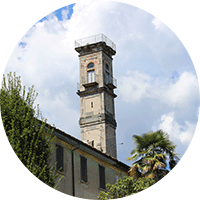is a municipality of about 2600 inhabitants in the Province of Como, in Lombardy.
Free Tour

CONVENT OF MONACHE BENEDETTINE
CONVENT OF MONACHE BENEDETTINE
The Monastery of Santa Maria in Lambrugo became, in that period, residence for lot of daughters of nobles from Milan and Brianza who aimed to a monastic carrier. To testimony the importance of the Monastery, ecclesiastic documents took note of several visits of Cardinal Federico Borromeo in 1600. The richness of the Monastery permitted the construction of the peanut tower, that is today one of the symbol of the town.
The comfortable habits of the nuns, legacy of their noble origins, with the costs for the enlargements of the Monastery, brought it rapidly on the brink of bankruptcy. Only the foundation of the first free school for the habitants postponed the closure of the Monastery. This was only delayed: when, in 1798, Repubblica Cisalpina rose, all the properties of the religious structure were sold to privates. The Monastery was naked of its wealth as its religious functions. Only in XX cent. was restored a part of the structure for religious aims. In a part of the Monastery, Suore Giuseppine and then Figlie di Gesù di Verona lived there, but in 1967 the building returned to be unused. Today, a part of the old Benedictine Monastery is a property of the Municipality of Lambrugo, while the other one is private. It is impossible to visit the interior, but you can walk around the building, that alternates parts of the original architecture with parts of recent restoration.

PANORAMIC POINT FROM THE OLD CHURCH
PANORAMIC POINT FROM THE OLD CHURCH
The church, with its majestic aspect, is divided into three naves with the same height. The entrances are three, set in archways which remain to the upper windows. In the church you can observe several frescos of Enrico Volontiero, as well as a marvellous bas relief, that represents the deposition of Jesus, and it was originally located in the Benedictine Monastery in the lower part of the town. The church of San Carlo is not the first one dedicated to the saint. An old church, realized in 1615 by the nobles Giussanis, was in fact placed where today is the oratory of Lambrugo, which has recovered the spaces after the deconsecration.
Exactly where the old church was, there is now a panoramic point and there you can observe the surroundings of Lambrugo. In the South-West countryside, which divides Lambrugo from Lurago d’Erba, there are Tenuta Pomelasca, Villa Sormani and other farmsteads which in the past served the noble villas. To the North you can also see the wooden mounts, as Cornizzolo and Bollettone, and the Lake Segrino, Pusiano and Alserio lay to the feet of them.

BAGGERO OASIS
BAGGERO OASIS
The reflections of the rocks and the surrounding trees seem immortalized in a photograph that changes its features as you walk along the path.
The peace and tranquillity of this spot and its astounding views firmly contrast with its recent history.
The beds of these two water holes, in fact, were carved into the mountain to extract material for the local industries.
A brutal injury to a fragile land and an equally delicate ecosystem.
But once again water has proved to be the source of life and, springing up from the bottom of the quarry, has put an end to extraction.
Over the years, a natural oasis has been created and maintained offering scenery that seems cut out from a postcard from faraway places up north.
Conifers are lush and wildlife is quite rich on land, water and sky.
The most suitable path to walk through the oasis leads to the borders of the two ponds and winds by a sort of raised jetty where you can enjoy the serenity of nature.
The Cavolto water conduit that gives rise to the lakes has sometimes been highly polluted due to the bad functioning of the sewer system of the neighbouring town. Bathing is then forbidden.
Waiting for better times, a visit to this area is a must for the uniqueness of the landscape that offers unexpected scenery and colours.
HOW TO REACH LAMBRUGO
By Bus:
ASF Bus Service
C 46 Como – Merate – Bergamo
By Train:
Trenord Railway service from Milano Nord Cadorna Regional Train R16 Asso – Seveso – Milano, stop at Lambrugo – Lurago d’Erba
By Car:
From Como: get SP 342 in direction to Bergamo
From Lecco: get SS 36 in direction to Milan, then get SP 342 at Nibionno in direction to Como
From Milan: get SS 36 in direction to Lecco and exit at Nibionno to SP 432 in direction to Como
Discover Green Lands
A Project by
Comune di Erba capofila, Comune di Albavilla, Comune di Albese con Cassano, Comune di Alserio,
Comune di Eupilio, Comune di Inverigo, Comune di Lambrugo, Comune di Lurago d’Erba,
Comune di Merone, Comune di Montorfano, Comune di Orsenigo, Comune di Ponte Lambro, Comune di Pusiano,
Sistema Turistico Lago di Como, Lariofiere Como Lecco, Confcommercio Como.
The project “Distretto dell’Attrattività Turistica Expo Green Land” is born thanks to the Regional DDG “Distretti dell’attrattività turistica e commerciale” 14 July 2014. Project n. 52574412.




